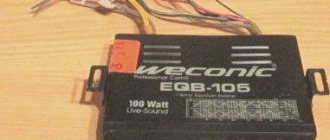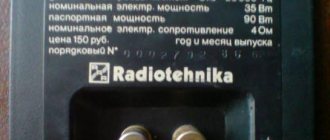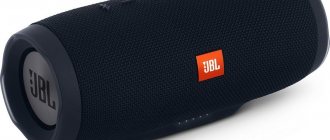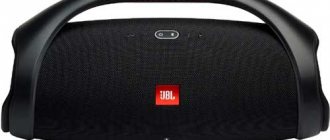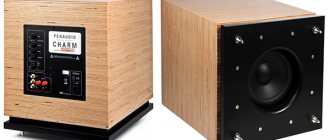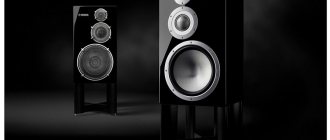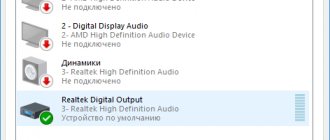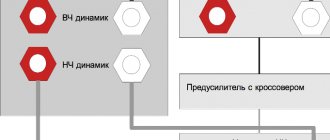25- 25 000
Harmonic distortion of speakers, %, determined by the total characteristic harmonic coefficient, at an average sound pressure level of 90 dB, in the frequency range, Hz, no more than:
250. 1000 1000 . 2000 2000 . 6300
Directional characteristic of the speaker, dB, determined by the deviation of the frequency response of sound pressure, measured at angles of 25±5° in the horizontal plane and 7° +3-2 in the vertical plane, from the frequency response measured along the acoustic axis of the speaker (0°):
in the vertical plane in the horizontal plane
Design Features:
The speaker body is made in the form of a rectangular non-demountable box made of chipboard. A set of heads was used: 75GDN-5 with an EMOS sensor, 20GDS-1-8 and 6GDV-6-16, produced by Radiotekhnika.
The heads are installed on the front panel of the speakers: the LF head is on the vertical axis of symmetry, and the MF and HF heads are to the left of the vertical axis of symmetry, one above the other.
The bass and midrange heads are each framed by a decorative overlay, blackened or without blackening, made by stamping from aluminum sheet, with four mounting holes.
The midrange head is isolated on the inside from the total volume of the housing by a special plastic casing in the shape of a truncated cone.
The HF head is framed by a plastic cover that protrudes above the front panel and simultaneously covers the entire upper part of the speaker's front panel and the display unit. For the HF head, this pad serves as a horn that improves the electroacoustic characteristics of the speakers in the high frequency range.
"S70" 35AC-013 1.4.1.3
"S70" 35AC-013
Manufacturer: PO “Radiotekhnika”, Riga.
Purpose and scope of application: for high-quality amplification and playback of one channel of a stereo audio program or for playback of a monophonic program.
The source of the program is intended to use a pre-amplifier, which has level and tone control, as well as switching with various devices: tape recorder, tuner, electric player, etc.
The speaker system has a built-in final power amplifier. The maximum power of the amplifier to which a passive speaker input can be connected is 160 W. The preferred installation option is floor-mounted.
To improve the sound at low frequencies, electromechanical feedback EMOS is used, which is carried out using an acceleration sensor in the woofer head. In order to expand consumer capabilities, the system provides a passive input, to which a signal from the output of an external power amplifier can be supplied to a switched-off speaker.
Specifications:
Сг3.843.042 TU.
Appearance 35AC-013
Shape of the frequency response of sound pressure 35AC-013, measured along the acoustic axis
Specifications:
| Specifications: | Meaning |
| Reproducible frequency range, Hz, in free half-space conditions | 25… 25000 |
| Uneven frequency response of sound pressure, dB, at the lower limit frequency relative to the level of average sound pressure | —17 |
| Average sound pressure, Pa (dB), at rated power in the range of 100… 8000 Hz, not less | 2,2(100,8) |
| Uneven frequency response of sound pressure, dB, in the frequency range 100…8000 Hz relative to the average sound pressure level | ±4 |
| Level of characteristic sensitivity of the passive input (characteristic sensitivity), dB in the frequency range 100 ... 8000 Hz, not less | 86 (0,4) |
| Harmonic distortion of speakers, %, determined by the total characteristic harmonic coefficient, at an average sound pressure level of 90 dB, in the frequency range, Hz, no more than: | |
| 250…1000 | 2 |
| 1000…20000 | 1,5 |
| 2000…6300 | 1 |
| Nominal electrical resistance of passive input (nominal value of total electrical resistance), OM | 4 |
| Minimum value of total electrical resistance, Ohm | 3,2 |
| Maximum noise (nameplate) power of passive input, W | 70 |
| Limit short-term power of passive input, W | 400 |
| Type of low-frequency acoustic design | closed body |
| Weight, kg, no more | 25 |
| Dimensions, mm | 325x580x265 |
| Directional characteristic of the speaker, dB, determined by the deviation of the frequency response of sound pressure, intended at angles of 25 ± 5° in the horizontal plane and 7 + 3/-2° in the vertical plane, from the frequency response measured along the acoustic axis of the speaker (0°): | |
| in the vertical plane | ±8 |
| in the horizontal plane | ±6 |
Design Features:
- The speaker body is made in the form of a rectangular non-demountable box made of particle board.
- A set of heads was used: 75GDN-5 with an EMOS sensor, 20GDS-1-8 and 6GDV-6-16, produced by Radiotekhnika.
- The heads are installed on the front panel of the speakers: the LF head is on the vertical axis of symmetry, and the MF and HF heads are to the left of the vertical axis of symmetry, one above the other. The bass and midrange heads are each framed by a decorative overlay, blackened or without blackening, made by stamping from aluminum sheet, with four mounting holes. The midrange head is isolated on the inside from the total volume of the housing by a special plastic casing in the shape of a truncated cone. The RF head is framed by a plastic cover that protrudes above the front panel and simultaneously covers the entire upper part of the front panel of the DS and the display unit. For the HF head, this pad serves as a horn that improves the electroacoustic characteristics of the speakers in the high frequency range.
- In the left corner of the trim there is a decorative nameplate with the name of the AC and the manufacturer's logo. On the right side of the overlay there are knobs for adjusting the midrange and treble levels with printed scales; The regulators provide separate adjustment of midrange and treble within ±3 dB in the ranges of 500...5000 Hz and 6...25 kHz, respectively. Next to the level control knobs there is a panel of indicators of the power level of the amplifier's output signal, which have five level values. The indicator scale is graduated: +3 dB, 0 dB, -10 dB, -20 dB, -60 dB, -40 dB. In this case, the power level indicator
- On the same panel there is an indicator that the speaker is connected to the network. The front panel also contains plastic bushings for attaching a decorative frame with fabric.
- The internal volume of the speaker (17.5 dm8) in order to reduce the influence on the frequency response of sound pressure and the sound quality of the speaker resonances of the internal volume of the cabinet is filled with a sound absorber, which is mats of technical wool, covered with gauze. The mats are located on the inner surfaces of the walls of the housings. On the rear wall of the case there is a power amplifier panel mounted on the inside of the panel. On its outer side there are: a radiator for powerful transistors, connectors for connecting a pre-amplifier, a button for turning on the network, a cord for connecting the network, passive input terminals and a decorative nameplate indicating the main technical characteristics. In addition, on the rear wall of the case in the upper part there is a chassis on which are located: an amplification and protection unit, a power board, and a ULF module.
- Inside the housing, on its rear wall, there is a board of passive filters that provide electrical separation of the low-frequency, mid-frequency and high-frequency speaker bands. Band separation frequencies are 750±50 Hz and 5000±600 Hz.
Schematic diagram of the UNCh-50-8 35AS-013 module
asmpa.com
S-70 Radiotehnika (35 AS-013) Active speaker
Active 3-way closed-type speaker system. With EMOS sensor (electromechanical feedback - acceleration sensor in the woofer head). Passive filters for filtering speakers.
S-70 Radiotehnika
In those years, it was impossible to implement normal multi-amping (one amplifier per speaker). The level of production and complete base did not allow this. Now you put one CHIP on 3 channels, and that’s it!
The only valuable solution in the AC, of course, was the EMOS sensor.
EMOS made it possible to greatly reduce the internal volume of the woofer chamber. And greatly reduce distortion.
| frequency Hz | Kg %. harmonic 2/3 | |
| with EMOS | without EMOS | |
| 31.5 | 9.4 / 6.8 | 20 / 13 |
| 40 | 2.8 / 2 | 7,4 / 4.0 |
| 50 | 1 / 1.1 | 1/1.2 |
| 63 | 1.6 / 0.8 | 2.2/0.8 |
| 80 | 1.2 / 0.5 | 1.9 / 0,6 |
75 GDN-5-4 with EMOS sensor
Bulky passive filters + amplifier in one product; in all other respects, a very stupid combination. It turned out to be a cumbersome monster, in itself - as it is, without the versatility of choosing options.
The speaker has a passive input, to which a signal from the output of an external power amplifier can be supplied to a switched-off speaker. But this is also a strange decision. Another external amplifier will not have EMOS - formally there will be sound, but the bass will be lost.
S-70
They were produced by the Riga Radio Plant named after AS.Popov since 1987. The retail price was 185 rubles.
S-70-AFC
Tech. characteristics :
| Reproducible frequency range, Hz, in free half-space conditions | 25- 25 000 |
| Uneven frequency response of sound pressure, dB, at the lower limit frequency | – 17dB!!! (they've set the bar) |
| Average sound pressure, Pa (dB), at rated power in the range of 100-8000 Hz, not less | 2,2 (100,8) |
| Uneven frequency response of sound pressure, dB, in the frequency range 100 ... 8000 Hz relative to the average sound pressure level | ±4 |
| Level of characteristic sensitivity of the passive input (characteristic sensitivity), dB (Pa/√W), in the frequency range 100 ... 8000 Hz, not less | 86(0,4) |
| Harmonic distortion of speakers, at an average sound pressure level of 90 dB, no more: 250... 1000, 1000...2000, 2000...6300 | 2 1,5 1 |
| Nominal electrical resistance of passive input, Ohm | 4 |
| Minimum value of total electrical resistance, Ohm | 3,2 |
| Maximum noise (nameplate) power of passive input, W | 70 |
| Limit short-term power of passive input, W | 400 |
| Type of low-frequency acoustic design | closed body |
| Weight, kg, no more | 25 |
| Dimensions, mm | 325 x 580 x 265 |
Heads : 75 GDN-5-4 with an EMOS sensor, 15 GD-11A and 10 GD-35 , produced by the same Radiotekhnika software.
A device consisting of amplification and protection blocks (U2). power amplifier (A), indication and adjustment, crossover filter, power supply and three dynamic heads, high-frequency B1 (10GD-35), mid-frequency B2 (15GD11A) and low-frequency VZ (Z0GD-6 with EMOS sensor). From the output of the power amplifier, the signal goes to separation filters. Its link C1 L2 R1 C8 passes high frequencies (5000..20 000 Hz), C2 L3 C3 L4 C9 R2 - middle ones (450... 5000 Hz), L1 C4 C5-C7 - low frequencies (30.450 Hz).
Scheme of the acoustic system "S-70"
S-70-View-back
The internal volume of the speaker is 17.5 liters. Band separation frequencies: 750 and 5000 Hz.
S-70-Filters
S-70-Amplifier
VEF Radiotehnika RRR – Radiotehnika S-70 (35AC-013)
Radiotehnika S-70 (35AC-013)
Three-way active acoustic systems with electromechanical feedback (EMOS) S-70 (35AC-013, 35AC-213) Sg3.843.042-84E are designed for high-quality amplification and reproduction of one channel of a stereo audio program or for reproduction of a monophonic program as part of household radio-electronic equipment.
In addition to three dynamic heads: LF - 30GD-6 with an EMOS sensor, MF - 15GD-11A, HF - 10GD-35 and passive crossover filters at 700 Hz and 5000 Hz, the speaker housing houses a power amplifier with a power supply. Main technical characteristics: Maximum noise (nameplate) power - 70 W Nominal power - 35 W Nominal electrical resistance - 4 Ohms (minimum value - 3.2 Ohms) Nominal voltage, providing an average sound pressure of 1.2 Pa active input - 0.5 V, passive input - 11.8 B Range of reproduced frequencies - 31.5...20000 Hz Unevenness of the frequency response of sound pressure at the lower frequency of the range relative to the level of average sound pressure -17 dB Unevenness of the frequency response of sound pressure in the range of 100...8000 Hz relative to the level of average sound pressure in the range of 50...20,000 Hz - ±4 dB Characteristic sensitivity - 86 dB (0.4 Pa/W0.5) Harmonic distortion of speakers, determined by the total characteristic harmonic distortion in the frequency range: 250...1000 Hz - 2%, 1000...2000 Hz - 1.5%, 2000...6300 Hz - 1% Speaker directivity characteristic, measured by the deviation of the frequency response of sound pressure at angles to the acoustic axis: in the vertical plane ±7° - ±8 dB in the horizontal plane ±25° - ±6 dB Power consumption - no more than 100 W Dimensions - 580x325x265 mm Weight — 25 kg
The author of the development (EMOS, amplifier) is Dzintars Lasis. The original speaker S-90 is Rolands Kerno. Patent for a speaker modeling device: 5700. Device for modeling the dynamic head of a loudspeaker 11/15/1984 author(s): Lasis Dzintars Arturovich, Kikhtenko Valery Zhanovich. Document No. 01124340
vef-rrr.ucoz.ru
Comments (10 of 12)
They ruined a good speaker. They could at least make the arrangement symmetrical
This is not the first time we have converted these acoustics into passive ones and every time we note the magnificent sound. The 75GDN-1-5 woofer works very well for this very small volume of the box. The main thing during the alteration was to ensure complete sealing of the volume. This is checked this way: on the assembled speaker, a constant voltage of 10 Volts is applied to the input terminals. In this case, the LF diffuser should slowly move to its extreme position. Let's remove the tension. The diffuser slowly returns to its place. The S70 filter does not protrude in the middle, as is often the case with the S90. IMHO, in terms of sound beauty, these speakers are second only to Electronics 35AC-015.
Well, what about the lows?))) Could they really go lower in frequency than the EMOS operation gave?))
That's it, I figured it out - from UP001 onwards to brig 001, the sound is good, and the bass is in place, both treble and midrange, the speakers still lived up to the expectation, thank you)))
Denis, bring the speaker to me, we’ll listen to the bass together
Manufacturer : Riga Radio Plant named after Popov.
Purpose and scope of application : for high-quality amplification and playback of one channel of a stereo audio program or for playback of a monophonic program. The source of the program is intended to use a pre-amplifier, which has level and tone control, and also carries out switching with various devices: tape recorder, tuner, electric player, etc. The speaker system has a built-in final power amplifier. The maximum power of the amplifier to which a passive speaker input can be connected is 160 W.
